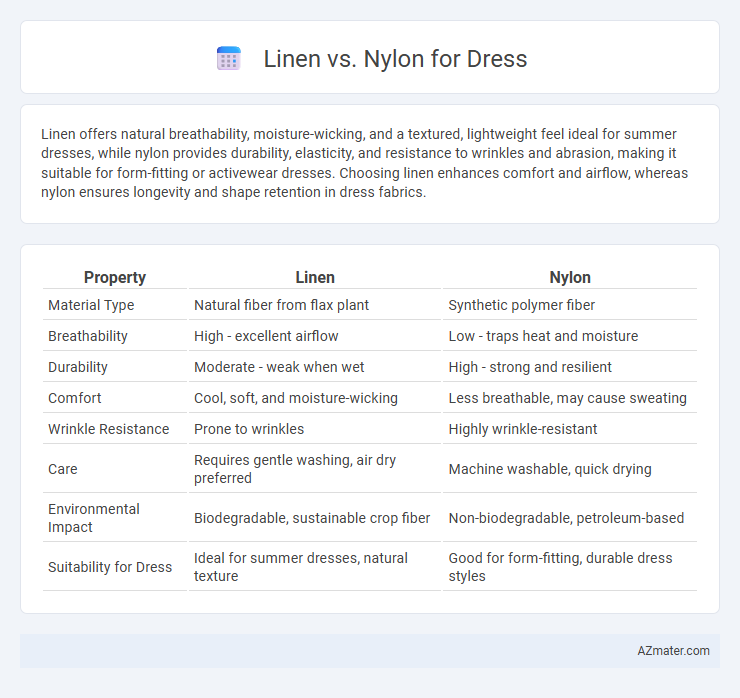Linen offers natural breathability, moisture-wicking, and a textured, lightweight feel ideal for summer dresses, while nylon provides durability, elasticity, and resistance to wrinkles and abrasion, making it suitable for form-fitting or activewear dresses. Choosing linen enhances comfort and airflow, whereas nylon ensures longevity and shape retention in dress fabrics.
Table of Comparison
| Property | Linen | Nylon |
|---|---|---|
| Material Type | Natural fiber from flax plant | Synthetic polymer fiber |
| Breathability | High - excellent airflow | Low - traps heat and moisture |
| Durability | Moderate - weak when wet | High - strong and resilient |
| Comfort | Cool, soft, and moisture-wicking | Less breathable, may cause sweating |
| Wrinkle Resistance | Prone to wrinkles | Highly wrinkle-resistant |
| Care | Requires gentle washing, air dry preferred | Machine washable, quick drying |
| Environmental Impact | Biodegradable, sustainable crop fiber | Non-biodegradable, petroleum-based |
| Suitability for Dress | Ideal for summer dresses, natural texture | Good for form-fitting, durable dress styles |
Introduction: Linen vs Nylon for Dresses
Linen and nylon are two popular fabrics commonly used in dressmaking, each offering distinct advantages suited for different occasions and styles. Linen, made from flax fibers, is prized for its breathability, natural texture, and moisture-wicking properties, making it ideal for warm weather and casual elegance. Nylon, a synthetic polymer, provides exceptional durability, elasticity, and resistance to wrinkles, often favored in activewear and form-fitting dresses.
Fabric Origins and Composition
Linen, derived from the flax plant, is a natural fiber known for its breathability and moisture-wicking properties, making it ideal for lightweight summer dresses. Nylon, a synthetic polymer invented in the 1930s, offers durability, stretch, and resistance to wrinkles and abrasions, commonly used in form-fitting or performance dresses. The fundamental difference in fabric origins and composition impacts the comfort, care, and environmental footprint of each material in dressmaking.
Comfort and Breathability Comparison
Linen offers superior breathability and moisture-wicking properties, making it ideal for keeping cool in warm weather, while nylon tends to trap heat and moisture, reducing comfort. The natural fibers in linen allow better air circulation and a lighter feel against the skin compared to the synthetic, less porous structure of nylon. For dresses worn in hot or humid climates, linen provides enhanced comfort and temperature regulation over nylon.
Durability and Longevity
Nylon offers superior durability and resistance to wear, making it less prone to tearing and abrasion compared to linen, which is more delicate and prone to creasing. Linen, though breathable and comfortable, tends to weaken over time with repeated washing and exposure to sunlight, reducing its longevity. Dresses made from nylon maintain their structural integrity longer, providing better value for long-term use.
Style and Aesthetic Appeal
Linen offers a naturally textured and breathable fabric that enhances a dress's casual elegance with its matte finish and subtle wrinkles, perfect for a relaxed yet sophisticated look. Nylon provides a smooth, shiny surface that contributes to a sleek, modern aesthetic, often used in body-hugging or structured dresses for a polished, high-fashion appeal. The distinct contrast between linen's organic, effortless charm and nylon's synthetic sheen allows designers to create versatile dress styles suited to varying fashion preferences.
Care and Maintenance Requirements
Linen dresses require gentle washing in cold water and air drying to prevent shrinkage and maintain fabric softness, while avoiding bleach to preserve natural fibers. Nylon dresses benefit from machine washing on a delicate cycle with mild detergent and quick drying, as the synthetic fibers resist wrinkles and shrinkage. Proper storage for both materials includes hanging linen in breathable covers to prevent mildew and folding nylon away from heat sources to avoid melting or deformation.
Environmental Impact and Sustainability
Linen, derived from flax plants, is highly sustainable due to its low water usage and biodegradability, making it an eco-friendly choice for dresses. Nylon, a synthetic fiber made from petrochemicals, has a significant environmental impact due to its energy-intensive production and non-biodegradable nature, contributing to microplastic pollution. Choosing linen over nylon reduces carbon footprint and supports sustainable fashion practices.
Cost and Accessibility
Linen dresses tend to be more expensive due to the labor-intensive production process and the natural fibers used, while nylon dresses are generally more affordable because synthetic materials cost less to produce. Linen offers breathability and durability but may require special care, making it less accessible for everyday wear compared to the easy-care and widely available nylon options. The cost difference and maintenance requirements significantly influence consumer accessibility and preference between linen and nylon dresses.
Ideal Uses: When to Choose Linen or Nylon
Linen is ideal for summer dresses and casual wear due to its breathability and moisture-wicking properties, making it perfect for hot, humid climates. Nylon excels in activewear and outdoor dresses because of its durability, elasticity, and quick-drying capabilities, suited for high-movement activities and wet conditions. Choosing linen suits those prioritizing natural fibers and comfort, while nylon fits scenarios demanding strength and weather resistance.
Conclusion: Which Fabric Suits Your Needs?
Linen offers breathability, natural texture, and excellent moisture-wicking properties ideal for hot weather and casual styles, while nylon provides durability, wrinkle resistance, and stretch suited for activewear and structured dresses. Choosing between linen and nylon depends on your priorities: select linen for comfort and natural fibers or opt for nylon when durability and ease of maintenance are crucial. Understanding these fabric characteristics ensures you pick the best material to match your lifestyle and dress requirements.

Infographic: Linen vs Nylon for Dress
 azmater.com
azmater.com